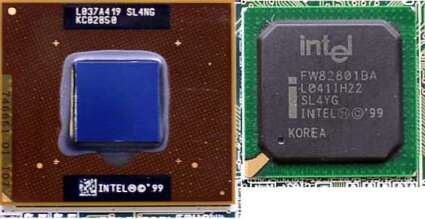Pricey Foundations: 9 Boards For The Pentium 4
Pricey Foundations: Boards With An Intel 850 Chipset, Continued
The Intel 850 chipset consists of two chips.
| Chipset | Intel 850 | Intel 845 | VIA P4X266 |
|---|---|---|---|
| Release Date | January 2001 | July 2001 | August 2001 |
| CPU Platform | Socket 423/478 | Socket 423/478 | Socket 423/478 |
| Processors supported | Intel Pentium 4 | Intel Pentium 4 | Intel Pentium 4 |
| Multiprocessor support | yes | no | no |
| Northbridge Chipset | Intel KC82850 | Intel 82845 | VIA VT8753 |
| Southbridge Chipset | Intel 82801 BA | Intel 82801 BA | VIA VT8233 |
| Front Side Bus speed | 100 MHz | 100 MHz | 100 MHz |
| Memory speed | 400 MHz | 100/133 MHz SDR/DDR | 100/133 MHz SDR/DDR |
| Synchronous Memory | no | no | yes |
| FSB Overclocking * | up to 133 MHz | up to 180 MHz | up to 200 MHz |
| DIMM slots | 4 | 4 | 4 |
| Max. Memory | 2048 MB | 2048 MB | 4096 MB |
| SDRAM support | no | yes | yes |
| DDR SDRAM support | no | yes | yes |
| VC SDRAM support | no | no | yes |
| RIMM support (Rambus) | yes | no | no |
| Dual RIMM support (Rambus) | yes | no | no |
| Ultra-DMA/33/66/100 | yes/yes/yes | yes/yes/yes | yes/yes/yes |
| USB ports | 4 | 6 | 6 |
| USB 2.0 | no | yes | no |
| PCI slots | 6 | 6 | 5 |
| Integrated Graphics | no | no | no |
| AGP 1x/2x/4x | yes/yes/yes | yes/yes/yes | yes/yes/yes |
| ACPI Features | yes | yes | yes |
* Depends on clock generatorComparison of chipsets that are currently available for Pentium 4.
Comparison of the chipsets currently available for the Intel Pentium 4.
These boards aren't exactly an overclocker's dream come true. Most of the candidates allow you to change only a handful of CPU settings. In addition to these inherent limitations, the Pentium 4 can only be underclocked - it's impossible to use the multiplier to overclock it. Those switching from a Pentium III/Socket 370 system will have additional costs to reckon with - using an Intel 850 board will probably also require investing in a new power supply to ensure that the voltage supply is stable enough for Pentium 4 CPUs running at higher clock speeds.
A Look At All Nine Test Candidates
All 9 candidates were able to withstand five days of testing in our Munich lab. The common denominator for all boards is the Intel 850 chipset, made up of two chips. Whereas the Intel 845 works with substantially cheaper SDRAM and will soon be compatible with DDR-SDRAM, the Intel 850 leaves you no option other than to use RDRAM. All the test candidates have made room for this high-octane memory in the form of four RIMM sockets that can be supplied with two or four RAM modules. Keep in mind, however, that you have to use pairs of modules, each with the same capacity.
In comparison to other tests, such as for VIA KT266 or Intel 815 boards, the benchmarks of the 850 boards differ only marginally from one another. There is a simple explanation for this - most manufacturers stick closely to Intel's reference design, thus resulting in only slight differences between them.
Get Tom's Hardware's best news and in-depth reviews, straight to your inbox.
Current page: Pricey Foundations: Boards With An Intel 850 Chipset, Continued
Prev Page Pricey Foundations: Boards With An Intel 850 Chipset Next Page Abit TH7: Features Galore